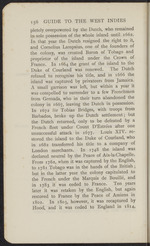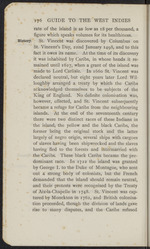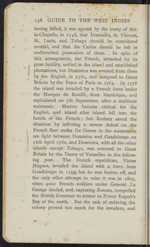| 1 |
 |
“...compelled to surrender to a few Frenchmen
from Grenada, who in their turn abandoned the
colony in 1667, leaving the Dutch in possession.
In 1672 Sir Tobias Bridges, with troops from
Barbados, broke up the Dutch settlement; but
the Dutch returned, only to be defeated by a
French fleet under Count D’Estrées after one
unsuccessful attack in 1677. Louis XIV. re-
stored the island to the Duke of Courland, who
in 1682 transferred his title to a company of
London merchants. In 1748 the island was
declared neutral by the Peace of Aix-la-Chapelle.
From 1762, when it was captured by the English,
to 1781 Tobago was in the hands of the British;
but in the latter year the colony capitulated to
the French under the Marquis de Bouillé, and
in 1783 it was ceded to France. Ten years
later it was retaken by the English, but again
restored to France by the Peace of Amiens in
1802. In r8o3, however, it was recaptured by
Hood, and it was ceded to England in 1814,...”
|
|
| 2 |
 |
“...of the island was
made to Lord Carlisle. In 1660 St. Vincent was
declared neutral, but eight years later Lord Wil-
loughby arranged a treaty by which the Caribs
acknowledged themselves to be subjects of the
King of England. No definite colonisation was,
however, effected, and St. Vincent subsequently
became a refuge for Caribs from the neighbouring
islands. At the end of the seventeenth century
there were two distinct races of these Indians in
the island, the yellow and the black Caribs, the
former being the original stock and the latter
largely of negro origin, several ships with cargoes
of slaves having been shipwrecked and the slaves
having fled to the forests and intermarried with
the Caribs. These black Caribs became the pre-
dominant race. In 1722 the island was granted
by George I. to the Duke of Montague, who sent
out a strong body of colonists, but the French
demanded that the island should remain neutral,
and their protests were recognised by the Treaty
of Aix-la-Chapelle in 1748...”
|
|
| 3 |
 |
“...ST. LUCIA
193
evacuate the island, only visiting it for the purpose
of securing wood and water until some definite
decision was arrived at. In 1748 the island was
declared by the Treaty of Aix-la-Chapelle to be
neutral. St. Lucia capitulated to Admiral Rodney
and General Monckton in 1762, but it was restored
to France in the following year by the Treaty of
Paris. When war broke out with France in 1778,
Rodney impressed upon the Government the
necessity of taking St. Lucia which he regarded
as an ideal naval base, and a powerful body of
troops was landed at Grand Cul de Sac Bay.
Count d’Estaing, who opposed them with a strong
force, was beaten off, and until the end of the war
the island remained British, in spite of an attempt
to recapture it in 1781; and it was from Gros
Islet Bay, at the north-east of the island, that
Rodney sailed with his fleet and inflicted a deci-
sive defeat on Count de Grasse between Dominica
and Guadeloupe on the memorable 12th April
1782. St. Lucia was restored...”
|
|
| 4 |
 |
“...238 GUIDE TO THE WEST INDIES
having failed, it was agreed by the treaty of Aix-
la-Chapelle, in 1748, that Dominica, St. Vincent,
St. Lucia, and Tobago should be considered
neutral, and that the Caribs should be left in
undisturbed possession of them. In spite of
this arrangement, the French, attracted by its
. great fertility, settled in the island and established
plantations, but Dominica was wrested from them
by the English in 1761, and assigned to Great
Britain by the Peace of Paris in 1763. In 1778
the island was invaded by a French force under
the Marquis de Bouillé, from Martinique, and
capitulated on 7th September, after a stubborn
resistance. Matters became critical for the
English, and island after island fell into the
hands of the French; but Rodney saved the
situation by inflicting a severe defeat on the
j French fleet under De Grasse in the memorable
■ sea fight between Dominica and Guadeloupe on
12th April 1782, and Dominica, with all the other
j islands except Tobago, was...”
|
|
